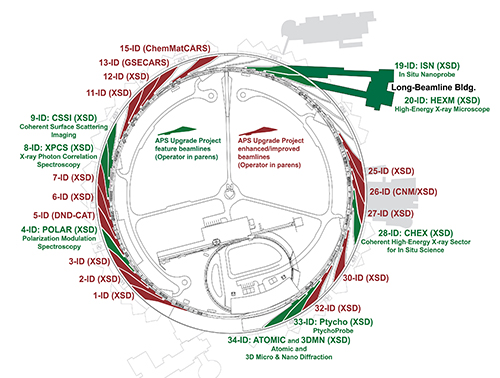|

Last month I discussed the various reviews we’ve undergone, and will continue to undergo, to ensure we have a robust path forward for the upgrade of the Advanced Photon Source (APS). This month I would like to focus on the recent and current efforts in experimental systems, which in total is about half of the total scope of the APS Upgrade Project. Specifically I want to mention a few activities the experimental systems team is undertaking right now to both complete early-construction beamlines and prepare other areas for future beamlines.
Before we get into that, however, I wanted to point out a resource for users that exists on the APS Upgrade web page. With the year-long installation period approaching quickly, some users may be wondering about alternative places to conduct their research. We have put together a chart of comparable capabilities at the other Department of Energy light sources in the United States. That chart is available to download, and we hope it is helpful to you.
Speaking of the APS Upgrade website, several recent stories posted there have discussed the transition to operations of several beamlines affected by the APS Upgrade. The relocation of spectroscopy and time-resolved research programs to their new home at 25-ID is underway. These programs were previously run out of sectors 7, 11, and 20, and the move to 25-ID signals a new beginning. By the end of the year, users will be conducting their first experiments at the new beamline. This also turns the page on the long-running spectroscopy program at 20-ID, and the staff recently held a celebratory toast to a quarter-century of great scientific achievement there. Steve Heald, who led that group for years, bears much responsibility for the success of these programs, and we wish him the very best on his recent retirement.
We have successfully installed the first APS Upgrade beamline instrument: a resonant inelastic x-ray scattering (RIXS) spectrometer at 27-ID. Users have already put this instrument through its paces, and the feedback has been positive.
One feature beamline that will not begin construction until the year-long installation period is the Coherent High-Energy X-ray (CHEX) station to be located at 28-ID. In the meantime though, this beamline is home to the Instrumentation Development, Evaluation and Analysis (IDEA) program, where optics and other components for the upgrade are tested. Read more about the IDEA beamline in this story.
Earlier this year the Long Beamline Building construction was completed. With that, work inside the building to create a future scientific facility is underway. The experimental enclosure for the High Energy X-ray Microscope (HEXM), located at 20-ID in the Long Beamline Building, is nearly complete. At roughly 20 meters, this will be the largest enclosure we’ve built at the APS, and will sit about 180 meters from the electron source. You can see a new photo of the HEXM enclosure at the top of this update. HEXM will enable the next steps forward in materials science, spotting even the smallest defects as they form in metals and other samples.
Work has begun on the In Situ Nanoprobe (ISN) facility, also located in the Long Beamline Building, at 19-ID. The experiment station for this beamline will be about 220 meters from the source, and it will enable deep probes into the mechanisms of batteries and solar cells as they charge and discharge, to name a couple.
Next in line for construction work will be 8-ID, which will transform into the new X-ray Photon Correlation Spectroscopy (XPCS) beamline, and 9-ID, which will become the Coherent Surface Scattering Imaging (CSSI) beamline. In August, a team working with the 8-ID beamline staff deconstructed both the 8-ID-E and 8-ID-I enclosures, leaving them all but empty to make room for the new beamline equipment. You can see a pair of timelapse videos of that deconstruction here.
With the installation period fast approaching, it is exciting and gratifying to see the start of many of our common dreams becoming reality. Thanks to the team for their continuing safe efforts to make all this happen.
As always, the most up-to-date information will be posted on the APS Upgrade web page. Thanks for your interest, and be safe.
Sincerely,
Jim Kerby
APS Upgrade Project Director
|

